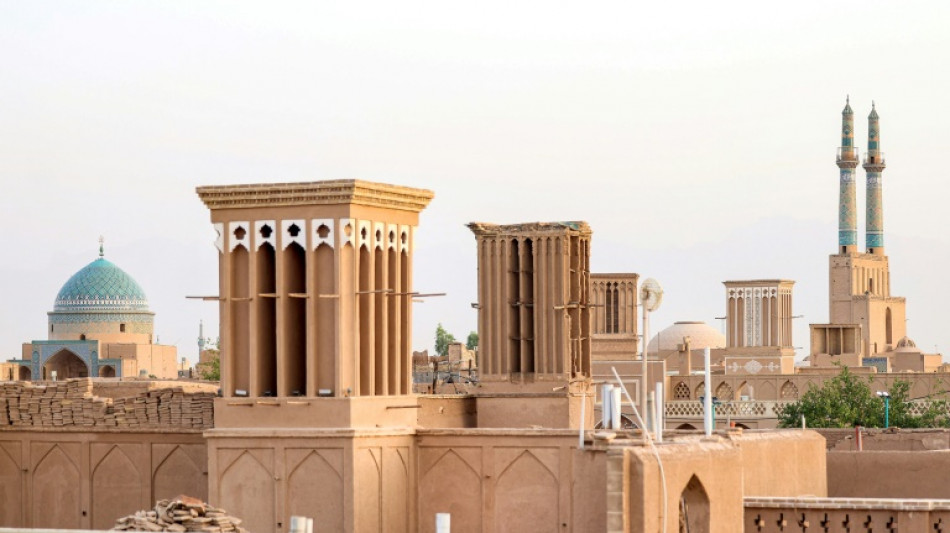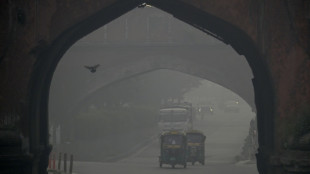
-
 Trump says all Canada trade talks 'terminated' over 'fake' ad
Trump says all Canada trade talks 'terminated' over 'fake' ad
-
Sheffield Wednesday file for administration

-
 Russia cuts key interest rate, warns of tepid growth
Russia cuts key interest rate, warns of tepid growth
-
Palestinian prisoners freed in hostage swap go from jail to exile

-
 Liverpool boss Slot backs Salah to end goal drought
Liverpool boss Slot backs Salah to end goal drought
-
China vows massive high-tech sector development in next decade

-
 French government faces threat of censure over wealth tax
French government faces threat of censure over wealth tax
-
Stocks diverge tracking US-China trade progress

-
 King Charles hosts Zelensky ahead of London meeting on Ukraine missiles
King Charles hosts Zelensky ahead of London meeting on Ukraine missiles
-
Pope Leo offers olive branch in allowing traditional mass

-
 EU accuses Meta, TikTok of breaking digital content rules
EU accuses Meta, TikTok of breaking digital content rules
-
French prosecutor demands maximum sentence for schoolgirl's murder

-
 Families search Mexican forest for remains of over 100 missing
Families search Mexican forest for remains of over 100 missing
-
Ace Tabuena lights up home course as Sarit leads in Philippines

-
 Acosta leaves it late to go fastest in Malaysian MotoGP practice
Acosta leaves it late to go fastest in Malaysian MotoGP practice
-
Patrick Reed: Bad press stings, but leave my kids out of it

-
 George Clooney explores passage of time in Netflix film 'Jay Kelly'
George Clooney explores passage of time in Netflix film 'Jay Kelly'
-
Young bodybuilders lift Japan's ailing care sector

-
 Stocks rally as traders cheer Trump-Xi meeting plan
Stocks rally as traders cheer Trump-Xi meeting plan
-
China, US 'can find ways to resolve concerns' as negotiators set to meet

-
 Trump says all Canada trade talks 'terminated'
Trump says all Canada trade talks 'terminated'
-
New Japan PM vows to take US ties to 'new heights' with Trump

-
 Women sue over sexual abuse in Australian military
Women sue over sexual abuse in Australian military
-
South Korea says 'considerable' chance Kim, Trump will meet next week

-
 Brazil's Lula says would tell Trump tariffs were 'mistake'
Brazil's Lula says would tell Trump tariffs were 'mistake'
-
Trump's Asia tour set to spotlight trade challenges

-
 Ivorian brothers dream of transforming cocoa industry
Ivorian brothers dream of transforming cocoa industry
-
Over 1,000 enter Thailand from Myanmar after scam hub raid

-
 Top Nigerian environmentalist sees little coming out of COP30
Top Nigerian environmentalist sees little coming out of COP30
-
Europe must nurse itself after US aid cuts: WHO director

-
 Venezuela's Maduro to US: 'No crazy war, please!'
Venezuela's Maduro to US: 'No crazy war, please!'
-
US, Japanese firms unwittingly hired North Korean animators: report

-
 Precision timing for Britain's Big Ben as clocks go back
Precision timing for Britain's Big Ben as clocks go back
-
False claim spreads of Japan 'mass deportations' ministry

-
 Alaska Airlines grounds entire fleet over IT outage
Alaska Airlines grounds entire fleet over IT outage
-
Ecuador's president says he was target of attempted poisoning

-
 Rybakina seals WTA Finals spot in reaching Tokyo semis
Rybakina seals WTA Finals spot in reaching Tokyo semis
-
Aldeguer fastest in rain-hit Malaysian MotoGP practice

-
 Herbert's three TD passes lead Chargers NFL rout of Vikings
Herbert's three TD passes lead Chargers NFL rout of Vikings
-
Gilgeous-Alexander hits career-high 55 in Thunder double overtime win

-
 Rebuilding wrecked Syria vital for regional stability: UN
Rebuilding wrecked Syria vital for regional stability: UN
-
India trials Delhi cloud seeding to combat deadly smog

-
 Top 14 offers France scrum-halves last audition as Dupont replacement
Top 14 offers France scrum-halves last audition as Dupont replacement
-
Mbappe's Real Madrid aiming to end Barca Clasico dominance

-
 Ashes in from the wilderness as England take on Australia
Ashes in from the wilderness as England take on Australia
-
High-flying Bayern pull away early in Bundesliga with Kane in complete control

-
 Isak-less Liverpool look to hit stride, Man City 'back' to their best
Isak-less Liverpool look to hit stride, Man City 'back' to their best
-
Asian stocks rally as traders cheer Trump-Xi meeting plan

-
 Japan inflation rises as new PM eyes economic package
Japan inflation rises as new PM eyes economic package
-
UK to press 'coalition of willing' for more long-range missiles for Ukraine


Iran's ancient 'wind catchers' beat the heat naturally
Tall, chimney-like towers rise from centuries-old adobe houses in Iran's desert city of Yazd, drawing in a pleasant breeze for residents of one of the hottest cities on earth.
The wind catchers, called badgirs in Persian, are just one of the engineering marvels inhabitants have developed in this ancient city in central Iran -- where temperatures reach well over 40 degrees celsius (104 Fahrenheit) in the summer.
And, unlike energy-guzzling air-conditioners, they're cost and carbon-free.
"For centuries, before we had electricity, they made it possible to cool dwellings," said Abdolmajid Shakeri, the provincial deputy of Iran's cultural heritage and tourism ministry.
The oldest of the city's 700 wind catchers dates back to the 14th century, but the architectural feature is believed to date back as far as 2,500 years when the Persian Empire ruled over much of the Middle East.
"The badgirs played a key role in the city's prosperity," said Shakeri about the desert city that was a caravan stop on the ancient Silk Road.
"Thanks to them, people lived at ease," he added, describing how the wind catchers pull fresh air into buildings and allow hot air to ventilate out through large vertical slots.
Majid Oloumi, the head of Dowlatabad garden, home to a towering 33-metre (100 foot) wind catcher -- one of the tallest in the world -- described the cooling method as "totally clean because it uses neither electricity nor polluting materials".
UNESCO listed Yazd as a World Heritage Site in 2017, describing the city as a "living testimony to intelligent use of limited available resources in the desert for survival".
-'Simplicity'-
The bioclimatic architecture which provides thermal comfort for the people of Yazd has attracted interest elsewhere on a heating planet.
"Badgirs demonstrate that simplicity can be an essential attribute to sustainability," said Paris-based architect Roland Dehghan Kamaraji, who has studied Iran's wind catchers.
"It goes against the common misconception that sustainable solutions need to be complex or high-tech."
At a sustainable urban community called Masdar city in the United Arab Emirates, buildings have been "designed to make use of the natural ventilation for cooling, like badgirs," he said.
Similarly, ventilation inspired by "termite mounds, an approach similar to that of badgirs" were built atop Eastgate Centre, a shopping mall and office complex in Harare, Zimbabwe.
However, Yazd's unique architectural traditions have largely been abandoned at their birthplace.
"Unfortunately, our ancestral heritage has been forgotten," especially since the emergence of air conditioners, said Oloumi.
Yazd's old town is a labyrinth of narrow streets and roofed alleyways. Its centuries-old edifices made of clay, mud-brick and adobe all provide insulation against the torrid heat.
But the old houses stand in sharp contrast to modern cement buildings and multi-lane roads.
"Today, house architecture imitates that in other countries, and cement-based construction does not correspond to the climate of Yazd," he added.
Kamaraji says bioclimatic architecture has waned due to economic constraints and modern construction methods that "largely favour the use of energy and fossil fuel intensive materials".
- Old but effective -
Another sustainable architectural feature of Yazd is its system of underground aqueducts called qanats, which transport water from underground wells, aquifers or the mountains.
"These underground aqueducts have great utility," said Zohreh Montazer, an expert on the water system. "They constitute a source of water supply and make it possible to cool the dwellings and to preserve food at an ideal temperature."
Iran is estimated to have around 33,000 operational qanats today, a significant drop from the 50,000 in use in the mid-20th century.
UNESCO says the decline in qanats is driven in part by the drying up of underground water sources due to overconsumption.
Iranian authorities have in recent years sought to rehabilitate the qanat of Zarch -- considered the longest and oldest, dating to some 3,000 years ago.
The water network -- which stretches over 70 kilometres across Yazd, and runs at a depth of around 30 metres -- stands as a reminder for Yazd's residents of the challenges ahead.
"The day when fossil fuels run out," said Montazer, "we will have to return to these methods."
M.Fischer--AMWN


